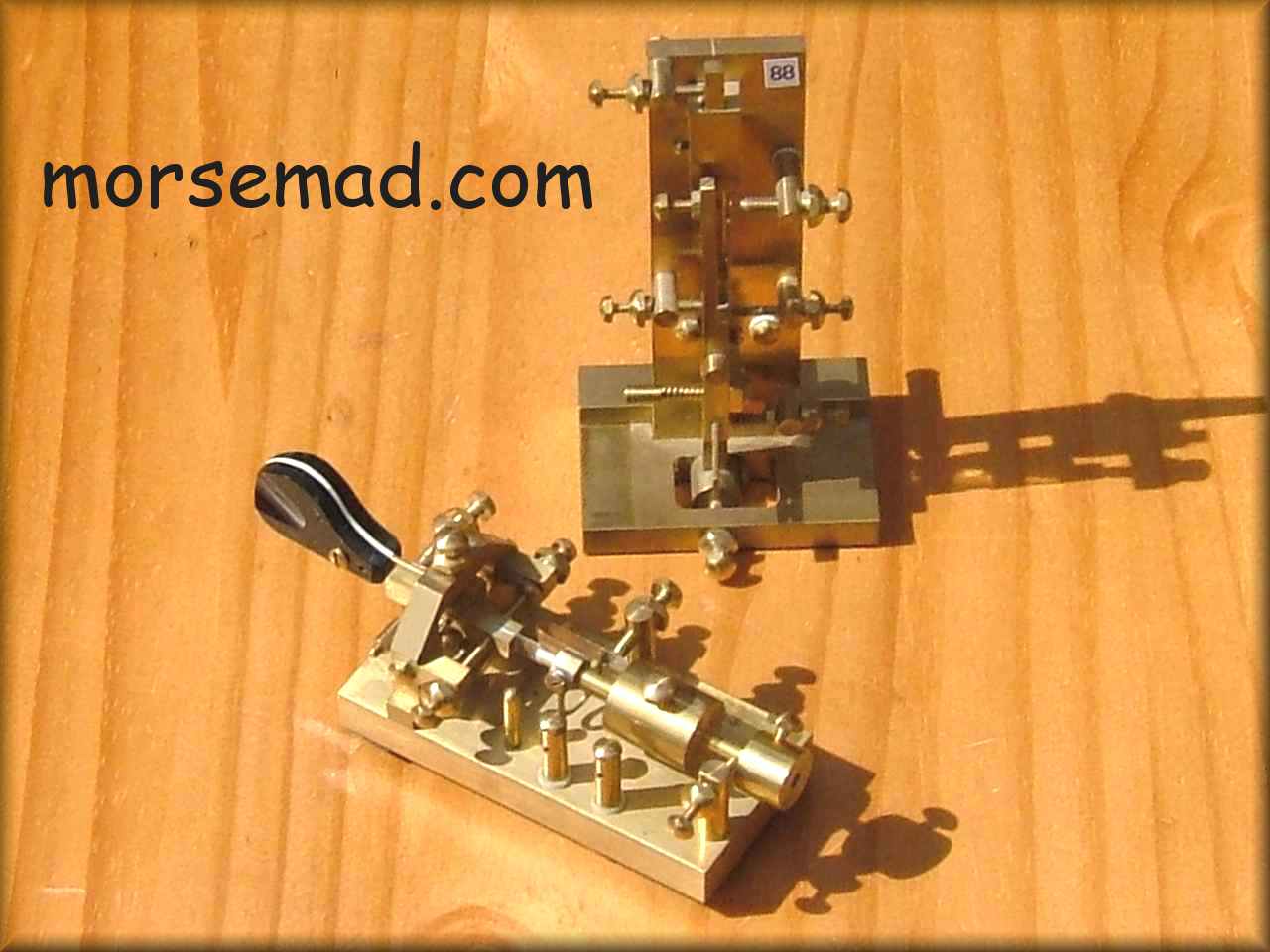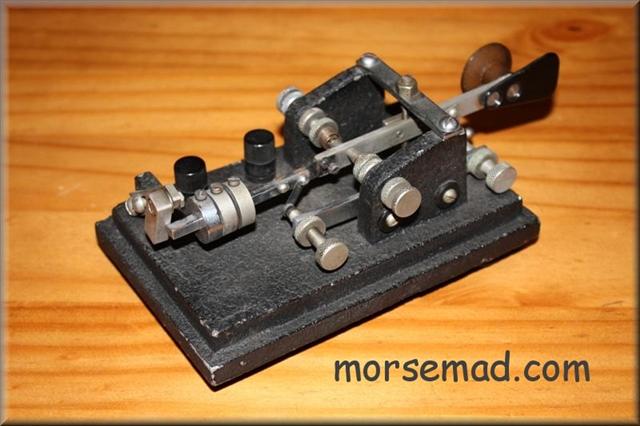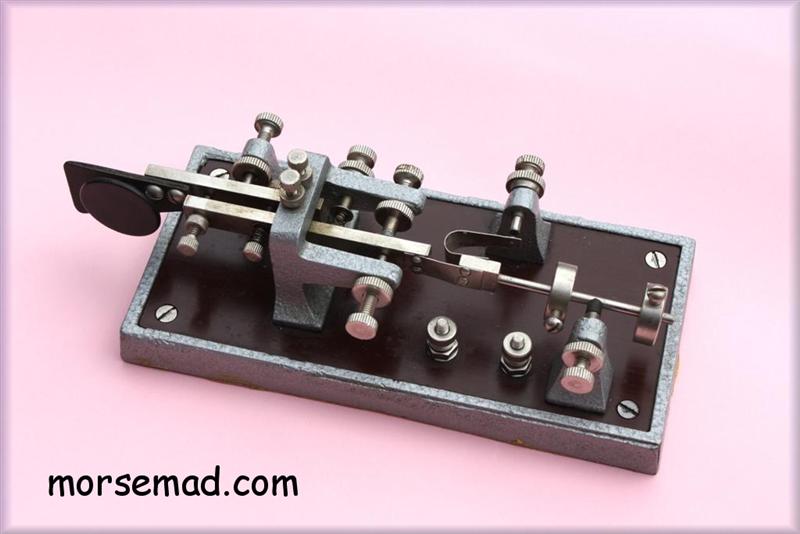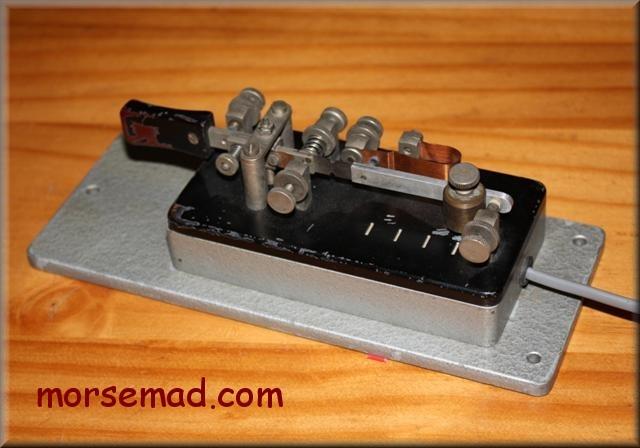
BUGS, BUGS, and more BUG Keys.
Semi Automatic keys, or Bugs as they are sometimes known, send dashes normally and dots automatically. Try this Virtual Bug key animation by Geoffrey Noles / AE4RV : Virtual Bug Project v.2
 222..... MECOGRAPH Bug Key circa 1908/09. First bug to beat the Vibroplex patent. Horace Martin's Vibroplex design created dots by tensioning a spring, but this design of morse code key creates dots by releasing tension on the spring and was invented by William Coffe. Mecograph Co. Cleveland, O, U.S.A. Patented FEB 13,06. MAY 28,07. MAY 5,08.
222..... MECOGRAPH Bug Key circa 1908/09. First bug to beat the Vibroplex patent. Horace Martin's Vibroplex design created dots by tensioning a spring, but this design of morse code key creates dots by releasing tension on the spring and was invented by William Coffe. Mecograph Co. Cleveland, O, U.S.A. Patented FEB 13,06. MAY 28,07. MAY 5,08.

Australian Coastal Radio History. Here is info on the man and company called BUZZA:
During its existence, ‘Buzza Products Sydney’ made a variety of keys from simple learners set to a very good straight key (Triumph or J-38 style), a not so very good straight brass key (an inferior copy of the PMG brass key) and a good bug key, the Buzza 100. The company also made buzzers, oscillators, etc.
The word BUZZA is derived from the word buzzer.
It all started when German Engineer AUGUST A. KRAUS migrated to Sydney in the 1930s.
After working for someone else, he started his own business, making Morse sets at a location near Clarence Street Sydney.
When war was declared on Germany, Kraus was interned at Sydney’s Long Bay Gaol , but was released to design and oversee the manufacture of Morse keys for the Australian Army and Navy.
After the war he kept on making keys, but at a reduced capacity.
In 1955 Buzza Products moved into new premises at 80 Hotham Parade Artarmon NSW. Here the production were mainly the now popular and relatively cheap toy Morse trainers. But here Buzza Products also made toy xylophones, toy Meccano sets, pipe cleaners and spinning wheels for potters.
The company ceased to exist in 1977, two years after the death of Mr Kraus.
Here is some information courtesy of Maurice / F5NQL :
 082..... Australian Bug THE BUZZA Type 100 circa 1940s. Used at Sydney Maritime Coast Station "VIS".
082..... Australian Bug THE BUZZA Type 100 circa 1940s. Used at Sydney Maritime Coast Station "VIS".

 083..... Australian Jigger Bug. The Simplex Auto was invented in 1920 and made by Leo Cohen in Melbourne, Australia. This is a Simplex Auto Standard Model in nice shiny all nickel plated finish, made in about 1941.
083..... Australian Jigger Bug. The Simplex Auto was invented in 1920 and made by Leo Cohen in Melbourne, Australia. This is a Simplex Auto Standard Model in nice shiny all nickel plated finish, made in about 1941.

 084..... Australian Jigger Bug. Here is another great Australian Simplex Auto Standard Model semi automatic key with a black base. The brass label reads "THE SIMPLEX AUTO (REGD) MANUFACTURED BY LEO G. COHEN MELBOURNE VIC".
Melbourne telegraphist Leo Cohen stopped making Simplex Auto jiggers after he went into the Army on 13th Nov. 1939, but his name appears on the Simplex Auto labels up to about S/No 5xxx.
084..... Australian Jigger Bug. Here is another great Australian Simplex Auto Standard Model semi automatic key with a black base. The brass label reads "THE SIMPLEX AUTO (REGD) MANUFACTURED BY LEO G. COHEN MELBOURNE VIC".
Melbourne telegraphist Leo Cohen stopped making Simplex Auto jiggers after he went into the Army on 13th Nov. 1939, but his name appears on the Simplex Auto labels up to about S/No 5xxx.

 524..... Australian Simplex Auto Key with great history! This key S/No 4135 circa 1940/41 was used from 1990 - 2006 in the radio shack of HMAS Vampire / VK2CCV by Wireless Operators of the NSW branch of the Royal Naval Amateur Radio Society (RNARS NSW). The Vampire is permanently alongside the wharf at Darling Harbour, Sydney, Australia and is one of the many attractions of the Australian National Maritime Museum. Just think of the QSO's made on this little beauty!
524..... Australian Simplex Auto Key with great history! This key S/No 4135 circa 1940/41 was used from 1990 - 2006 in the radio shack of HMAS Vampire / VK2CCV by Wireless Operators of the NSW branch of the Royal Naval Amateur Radio Society (RNARS NSW). The Vampire is permanently alongside the wharf at Darling Harbour, Sydney, Australia and is one of the many attractions of the Australian National Maritime Museum. Just think of the QSO's made on this little beauty!

 085..... French Bug Key. Vibro Mors Type A circa 1950s.
085..... French Bug Key. Vibro Mors Type A circa 1950s.

 087..... Canadian Bug made for the Royal Canadian Air Force by Wilson, Toronto. Circa 1940.
087..... Canadian Bug made for the Royal Canadian Air Force by Wilson, Toronto. Circa 1940.

 088&089. A Canadian Vertical Bug and a MINI Bug, both made by Merric of Ontario. The vertical bug known as the "MERRICK VERTICAL BUG KEY" can be seen on the front cover of Morsum Magnificat Nr77, Sept/Oct 2001. The photo shows the vertical without it's paddles fitted.
088&089. A Canadian Vertical Bug and a MINI Bug, both made by Merric of Ontario. The vertical bug known as the "MERRICK VERTICAL BUG KEY" can be seen on the front cover of Morsum Magnificat Nr77, Sept/Oct 2001. The photo shows the vertical without it's paddles fitted.

 090..... American McElroy bug. "Hole In THe Wall" Made by Telegraph Apparatus Co. Circa 1936/1938.
090..... American McElroy bug. "Hole In THe Wall" Made by Telegraph Apparatus Co. Circa 1936/1938.
TAC - a company involving T.R. McElroy, this key features a square main frame with a large circular hole through the centre, thus aquiring the name the Hole In The Wall.

 091. .... American Bunnell Martin Flash Bug Type 5-48. Circa 1930s.
091. .... American Bunnell Martin Flash Bug Type 5-48. Circa 1930s.

 092..... American Logan Speed X Bug. T-Bar Model 501. Circa 1930s. The label reads "SPEED X. MODEL 501. MFD BY LES LOGAN CO. SAN FRANCISCO. CALIF. U.S.A." An all chrome finish to this key with rounded corners to the base and 1/4" dot and dash contacts.
092..... American Logan Speed X Bug. T-Bar Model 501. Circa 1930s. The label reads "SPEED X. MODEL 501. MFD BY LES LOGAN CO. SAN FRANCISCO. CALIF. U.S.A." An all chrome finish to this key with rounded corners to the base and 1/4" dot and dash contacts.

 093..... American Logan Reverse Frame Bug. Circa late 1930s. A Logan Speed X Model 501 Professional. Has similar looks to the early Speed X of Les Logan, with a 6 1/4" by 3 1/2" nickel plated base and a reverse frame where the arms extend to the rear to carry the pivots. Three feet held on with pins and not screws. Also has the 1/4" contacts. Supplied without a label to various retail outlets in America.
093..... American Logan Reverse Frame Bug. Circa late 1930s. A Logan Speed X Model 501 Professional. Has similar looks to the early Speed X of Les Logan, with a 6 1/4" by 3 1/2" nickel plated base and a reverse frame where the arms extend to the rear to carry the pivots. Three feet held on with pins and not screws. Also has the 1/4" contacts. Supplied without a label to various retail outlets in America.

 094..... American Logan Speed X Model 510. Circa 1930/40s. This is a smart little bug with a nice black and gold finish. The base is hollowed out cast metal with the three feet on pins, the base measures 5 3/4" by 2 1/2". The label reads "SPEED X. MODEL 510. MFD BY LES LOGAN CO. SAN FRANCISCO. CALIF. U.S.A."
094..... American Logan Speed X Model 510. Circa 1930/40s. This is a smart little bug with a nice black and gold finish. The base is hollowed out cast metal with the three feet on pins, the base measures 5 3/4" by 2 1/2". The label reads "SPEED X. MODEL 510. MFD BY LES LOGAN CO. SAN FRANCISCO. CALIF. U.S.A."

 095. .... A British bug key (Or is it?) believed made by the Northampton Plating Company, Nottingham, England, c1946. Some labelled "Radio-Aid". This one pictured has a square shaped pendulum. A few known with a blue/grey finished base, and a round pendulum design, plus labelled as the "RADIO-AID" bug key.
095. .... A British bug key (Or is it?) believed made by the Northampton Plating Company, Nottingham, England, c1946. Some labelled "Radio-Aid". This one pictured has a square shaped pendulum. A few known with a blue/grey finished base, and a round pendulum design, plus labelled as the "RADIO-AID" bug key.
Note the unusual swinging bar damper design, rather than the usual wheel style found on the majority of bug keys. As the key has a USA made switch and American screw threads, I am inclined to think this is an American bug key.

 096..... American Bug Speed X 114-520 by E. F. Johnson. (Successor to Logan). This model is like the 515 but with a circuit closer added and a new E. F. JOHNSON nameplate.
096..... American Bug Speed X 114-520 by E. F. Johnson. (Successor to Logan). This model is like the 515 but with a circuit closer added and a new E. F. JOHNSON nameplate.

 097. .... American Bug made by Hess Manufacturing Co. c1987. There is an "I" type damper and a shorting lever. The label reads "HESS MFG. CO." in large letters. The dot spring has a wire dot tamer and the base measures 7" long by 2 & 1/2" wide and 1/2" thick. Apart from the label, the screw heads are cross head types.
097. .... American Bug made by Hess Manufacturing Co. c1987. There is an "I" type damper and a shorting lever. The label reads "HESS MFG. CO." in large letters. The dot spring has a wire dot tamer and the base measures 7" long by 2 & 1/2" wide and 1/2" thick. Apart from the label, the screw heads are cross head types.
 098..... American Kenco Bug Key. Made by the Kenmore Co. of Boston and sold by Radio Shack in the 1930's. Fairly rare.
Two models are known. One as here with two levers, and another with a split arm mechanism.
Herman / VK2IXV has one with a label that reads "PAT. APL'D FOR. RAYLYNN MFG. BOSTON - MASS.
098..... American Kenco Bug Key. Made by the Kenmore Co. of Boston and sold by Radio Shack in the 1930's. Fairly rare.
Two models are known. One as here with two levers, and another with a split arm mechanism.
Herman / VK2IXV has one with a label that reads "PAT. APL'D FOR. RAYLYNN MFG. BOSTON - MASS.

 099..... American J-36 Bug made by The Lionel Corp., for the US Army 1942.
099..... American J-36 Bug made by The Lionel Corp., for the US Army 1942.

 100..... Adgil Bug Key. Rare British Adgil Bug Key serial Nr 004. This key can be seen on page 36 of Morsum Magnificat issue number 77, plus MM76 page 46. Originally sold by Webb's Radio, Soho, London in 1939. It is stamped with the serial number 004 and it is believed that only ten were ever made. The base is, unusually for a bug key, made of wood and measures roughly 6" by 2 & 3/4" by 5/8" (150mm x 72mm x 12mm). Adgil Bug key Serial No 006 is in the collection of Martin Oldenbach
100..... Adgil Bug Key. Rare British Adgil Bug Key serial Nr 004. This key can be seen on page 36 of Morsum Magnificat issue number 77, plus MM76 page 46. Originally sold by Webb's Radio, Soho, London in 1939. It is stamped with the serial number 004 and it is believed that only ten were ever made. The base is, unusually for a bug key, made of wood and measures roughly 6" by 2 & 3/4" by 5/8" (150mm x 72mm x 12mm). Adgil Bug key Serial No 006 is in the collection of Martin Oldenbach

 101..... Limited Edition British Bug Key made for Icom, Herne Bay, Kent. Circa 1960/70. I have learned that the Icom company was originally called Thanet Electronics and changed its name
to Icom UK Ltd in 1985. So probably should be refered to as a Thanet Bug.
101..... Limited Edition British Bug Key made for Icom, Herne Bay, Kent. Circa 1960/70. I have learned that the Icom company was originally called Thanet Electronics and changed its name
to Icom UK Ltd in 1985. So probably should be refered to as a Thanet Bug.

 107.Jablonsky FME-33...... Miniature version of the Novoplex bug key. Similar to the Novoplex but smaller sized,
about 50% of the original Novoplex size. Used
by East German Stasi and coastal stations. Quite a small bug key, the key dimensions are 120mm by 60mm (4&5/8" by 2&1/4") and the larger grey base is 195mm by 80mm (7&5/8" by 3&1/8") Rare.
107.Jablonsky FME-33...... Miniature version of the Novoplex bug key. Similar to the Novoplex but smaller sized,
about 50% of the original Novoplex size. Used
by East German Stasi and coastal stations. Quite a small bug key, the key dimensions are 120mm by 60mm (4&5/8" by 2&1/4") and the larger grey base is 195mm by 80mm (7&5/8" by 3&1/8") Rare.

 105-6..... The Japanese DENTSU SEIKI BK-100 Bug Key. Marketed under several names, including Lafayette, CALRAD, Skillman, Hi-Mound, Jelectro, Eagle and Swallow. Circa 1960's. Two slightly different examples - the top one has a black & chrome label and a gray base. The other one has a cream & gold label + an orange coloured base.
105-6..... The Japanese DENTSU SEIKI BK-100 Bug Key. Marketed under several names, including Lafayette, CALRAD, Skillman, Hi-Mound, Jelectro, Eagle and Swallow. Circa 1960's. Two slightly different examples - the top one has a black & chrome label and a gray base. The other one has a cream & gold label + an orange coloured base.

 514..... A superb example of a Japanese DENTSU SEIKI "Swallow" bug key "BK-50". This bug was not designed with a cover. Circa 1950's.
514..... A superb example of a Japanese DENTSU SEIKI "Swallow" bug key "BK-50". This bug was not designed with a cover. Circa 1950's.